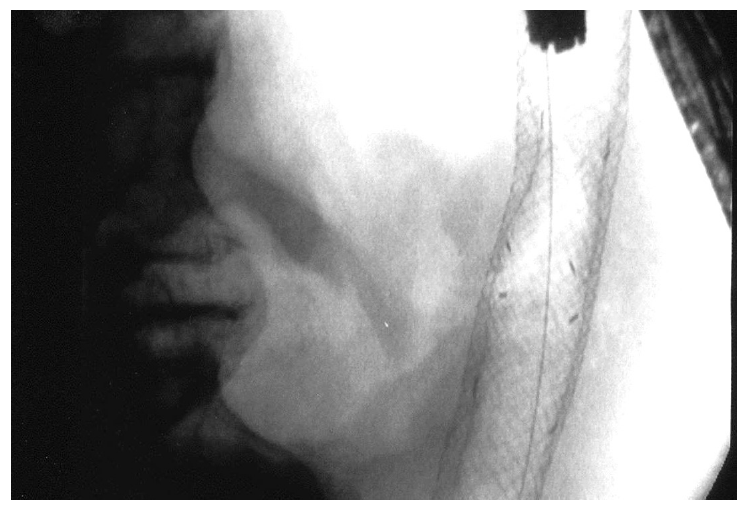INTRODUCTION
When cologastric fistulas occur in cases of malignancy, the tumor stage is often advanced and resection is impossible. Since the symptoms and the metabolic and nutritional consequences of cologastric fistulas are often detrimental to the patients, effective palliative measures other than surgery are often required. Covered self-expanding metal stents (SEMSs) are commonly used to seal esophagorespiratory fistulas, but a similar use of covered SEMSs has not been reported for fistulas arising from the colon.
CASE REPORT
A 75-year-old man known to have a locally advanced tumor in the transverse colon was readmitted to our department because of generalized weakness, nausea, vomiting, and increasing abdominal pain. Three months earlier, he had undergone SEMS insertion owing to tumor obstruction. Subsequent computed tomography (CT) of the chest, abdomen, and pelvis showed a tumor in the transverse colon, with involvement of the jejunum and the greater curvature of the stomach, together with local carcinomatosis. Biopsies showed colonic adenocarcinoma. Owing to the clinical condition of the patient and the advanced state of cancer, he was not deemed suitable for curative resection or palliative chemotherapy; instead, he underwent only stent placement and received regular blood transfusions.
When the patient was readmitted, he presented with feculent and bloody vomiting. A CT scan of the abdomen showed a cologastric fistula from the anal side of the tumor. A repeat colonoscopy was performed. The stented tumor area could easily be identified on both fluoroscopy and endoscopy. It was possible to pass the colonoscope through the previously stented segment. A guidewire was introduced with the tip of the colonoscope at the oral side of the tumor to ensure that the guidewire was positioned intraluminally along the entire length of the previous stent. The endoscope was then retracted to the anal end of the primary stent, and the guidewire was safely positioned. A covered COMVI enteral colonic stent (22У80 mm, CCT2208BA; Taewoong Medical Co. Ltd., Seoul, Korea) was introduced through the instrument channel of the colonoscope and passed over the guidewire through the previously stented segment. The COMVI enteral colonic stent has a biocompatible polytetrafluoroethylene membrane tube, which is held between an inner and outer unfixed cell structure mesh. It has three radiographic markers at the proximal, central, and distal parts of the stent, respectively. The stent was positioned such that the middle marker of the stent was aligned with the center of the previous stent.
Fluoroscopy was continuously used during stent placement. Care was taken to ensure that the middle radiographic marker of the COMVI stent was aligned with the center of the previous stent. Fig. 1 shows the endoscopic view of the distal end of the stent immediately after placement. Fig. 2 shows the fluoroscopic image of the colonoscope, the two stents, and the guidewire immediately after placement. Follow-up radiography with water-soluble contrast injection through the gastric tube showed the passage of contrast into the small bowel and from the stomach through the fistula to the outer surface of the stent (Fig. 3). After 15 minutes of continuous monitoring, no leakage of contrast into the colon was observed. The vomiting stopped, and the patient was able to tolerate oral intake.
DISCUSSION
The present case illustrates the first reported use of a covered stent to effectively seal a cologastric fistula. Palliative treatment of fistulas with covered stents is well known and has become the method of choice for treating malignant esophagorespiratory fistulas. More than 90% of esophagorespiratory fistulas are occluded using this technique [1,2]. The most common cause of relapse is stent migration or tumor overgrowth with the development of a new fistula [3,4].
Malignant fistulation between the stomach and large bowel is a rare complication. In Western countries, this condition is most commonly associated with advanced adenocarcinoma of the transverse colon, whereas in Japan, gastric cancer is the most common cause [5,6]. Cologastric fistulas usually arise between the distal half of the transverse colon and the greater curvature of the stomach because of their close anatomical relationship. There are two main theories regarding the pathogenesis of fistula formation: the tumor may grow across the gastrocolic omentum from the originating organ, or alternatively, the primary tumor may develop an ulcer that provokes a surrounding inflammatory reaction, which in turn leads to the adherence and eventual fistulation between the two organs [5-7].
Cologastric fistulas are associated with a broad spectrum of clinical symptoms. The classic triad of symptoms is diarrhea, weight loss, and stercoraceous breath or fecal vomiting [5-10]. Gastrointestinal loss of water and electrolytes as well as metabolic disorders may lead to vitamin insufficiency and severe malnutrition. Owing to a combination of malnutrition and sepsis, patients can present with respiratory, hepatic, and renal insufficiency as well as disorders of the hemopoietic system such as anemia, leucopenia, and thrombocytopenia [6].
When patients present with a cologastric fistula caused by carcinoma of the transverse colon, the disease is often so advanced that the condition is incurable and management is palliative. Stenting with fistula sealing can relieve the above-mentioned symptoms, which is important for short-term gastrointestinal functionality in patients, although it may not palliate other symptoms such as bleeding and pain. Furthermore, stenting with fistula sealing does not prolong survival.
Self-expanding stents are often used as a bridge to surgery or in the palliative management of malignant colorectal obstruction. The risk of migration is significantly higher with covered stents than with uncovered stents [10]. Placement of a covered stent within an uncovered stent in the case of malignant colonic obstruction has been recommended to prevent stent migration and tumor ingrowth [11]. In the palliative setting, stenting is a safe procedure with low morbidity and mortality rates. It allows for the possibility of re-intervention with an additional stent in the case of stent migration or fistula relapse. In the case of fistulation, as presented here, a covered stent may provide considerable palliation.









